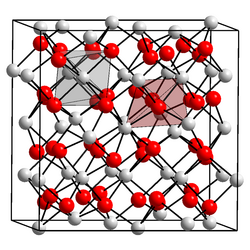 | |

| |
| Names | |
|---|---|
| IUPAC names
Einsteinium sesquioxide
Dieinsteinium trioxide Einsteinium(III) oxide | |
| Identifiers | |
| ChemSpider |
|
PubChem CID
|
|
| Properties | |
| Es2O3 | |
| Molar mass | 554 g/mol (253Es) |
| Appearance | colourless solid[1] |
| Structure | |
| Hexagonal | |
| Ia3 | |
a = 370 pm, c = 600 pm[2]
| |
Except where otherwise noted, data are given for materials in their standard state (at 25 °C [77 °F], 100 kPa).
| |
Einsteinium(III) oxide is an oxide of the synthetic actinide einsteinium which has the molecular formula Es2O3. It is a colourless solid.[1]
Three modifications are known. The body-centered cubic form has lattice parameter a = 1076.6 ± 0.6 pm; this allows the ionic radius of the Es3+ ion to be calculated as 92.8 pm.[3] The other two forms are monoclinic and hexagonal: the hexagonal form has the lanthanum(III) oxide structure.[4]
Einsteinium(III) oxide can be obtained by annealing einsteinium(III) nitrate in sub-microgram quantities.[3]
References
- ^ a b Arnold F. Holleman, Nils Wiberg: Lehrbuch der Anorganischen Chemie, 102nd Edition, de Gruyter, Berlin 2007, ISBN 978-3-11-017770-1, p. 1972.
- ^ Christine Guéneau; Alain Chartier; Paul Fossati; Laurent Van Brutzel; Philippe Martin (2020). "Thermodynamic and Thermophysical Properties of the Actinide Oxides". Comprehensive Nuclear Materials 2nd Ed. 7: 111–154. doi:10.1016/B978-0-12-803581-8.11786-2. ISBN 9780081028667. S2CID 261051636.
- ^ a b R. G. Haire, R. D. Baybarz: "Identification and Analysis of Einsteinium Sesquioxide by Electron Diffraction", in: Journal of Inorganic and Nuclear Chemistry, 1973, 35 (2), S. 489–496; doi:10.1016/0022-1902(73)80561-5.
- ^ R. G. Haire, L. Eyring, in: Handbook on the Physics and Chemistry of Rare Earths, Vol. 18 Lanthanoids and Actinides Chemistry (hrsg. von K. A. Gscheidner, Jr., L. Eyring, G. R. Choppin, G. H. Lander), North-Holland, New York 1994, S. 414–505.
Further reading
- Haire, Richard G. (2006). "Einsteinium". In Morss, Lester R.; Edelstein, Norman M.; Fuger, Jean (eds.). The Chemistry of the Actinide and Transactinide Elements (PDF). Vol. 3 (3rd ed.). Dordrecht, the Netherlands: Springer. pp. 1577–1620. doi:10.1007/1-4020-3598-5_12. Archived from the original (PDF) on 2010-07-17.
